
Welcome to the nutritional potassium content in 12 different types of wine, ranging from 127.00 mg to 39.00 mg per 100g. The basic type of wine is Vinegar, red wine, where the amount of potassium in 100g is 39.00 mg. 39.00 mg of potassium per 100g, from Vinegar, red wine corresponds to 1% of the potassium RDA. For a typical serving size of 1.000 tbsp (or 14.90 g) the amount of Potassium is 5.81 mg. This corresponds to an RDA percentage of 0%.
The percentage of the recommended daily allowance (RDA) for potassium is based on a 4700 mg RDA level for a mature adult.
Top five wine products high in potassium
Below is a summary list for the top five wine items ranked by the amount or level of potassium in 100g.
1. Alcoholic beverage, wine, table, red : 127.00mg (3%RDA)
2. Alcoholic Beverage, wine, table, red, Merlot : 127.00mg (3%RDA)
3. Alcoholic beverage, wine, table, all : 99.00mg (2%RDA)
4. Alcoholic beverage, wine, dessert, sweet : 92.00mg (2%RDA)
5. Alcoholic beverage, wine, dessert, dry : 92.00mg (2%RDA)
Following on from the five top wine items or products containing potassium we have a more comprehensive break down of Vinegar, red wine, and the highest item containing potassium which is Alcoholic beverage, wine, table, red. We also give a comparison of average values, median values and lowest values along with a comparison with other food groups and assess the effects of storage and preparation on the 12 types of wine.
At the bottom of the page is the full list for the 12 different types of wine based on the content in different servings in grams and oz (and other serving sizes), providing a comprehensive analysis of the potassium content in wine.
Vinegar, red wine - Nutritional Content and Chart
The full nutrition content, RDA percentages and levels for Vinegar, red wine should be considered along with the potassium content.Other important and potassium related nutrients are Energy, Sodium, Protein, Total Fat and Carbohydrate. For this 100g serving in your diet, the amount of Energy is 19.00 kcal (1% RDA), the amount of Sodium is 8.00 mg (1% RDA), the amount of Protein is 0.04 g, the amount of Total Fat is 0.00 g and the amount of Carbohydrate is 0.27 g. The nutritional content and facts for 100g, which includes Energy, Sodium, Protein, Total Fat and Carbohydrate is shown in the RDA chart below as percentages of the recommended daily allowance along with the potassium levels in wine.
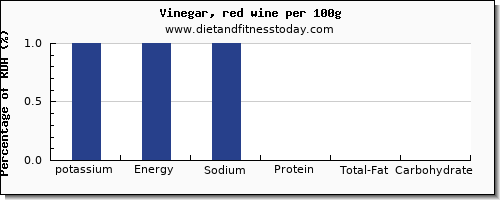
Our proprietary nutritional density score gives a nutritional value out of 100 based on 9 different vitamins, minerals and macro nutrients. Vinegar, red wine has a nutritional value score of 14.00 out of 100.Comparing the potassium content and the nutritional density in 100g for Vinegar, red wine; We class this as a medium to low potassium content item.In terms of overall nutritional value we class this as an item with a medium nutritional density value.
Amount of potassium per 100 Calories
100 calories of vinegar, red wine is a serving size of 0 g, and the amount of Potassium is 0 mg (0% RDA). Other important and related nutrients and macronutrients such as Protein, in 100 Calories are as follows; Energy 0 kcal (0% RDA), Sodium 0 mg (0% RDA), Protein 0 g (0% RDA), Total Fat 0 g (0% RDA), Carbohydrate 0 g (0% RDA). This is shown in the potassium RDA percentage chart below, based on 100 Calories, along with the other important nutrients and macro nutrients.
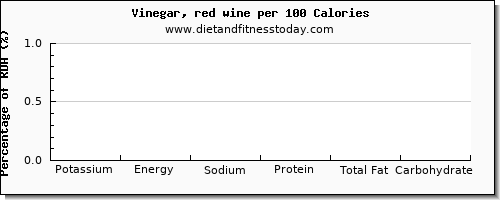
Content per Typical Serving Size 1.000 tbsp (or 14.90 g)
For the food Vinegar, red wine the typical serving size is 1.000 tbsp (or 14.90 g) which contains 5.81 mg of Potassium. In terms of the gram weight and total content for this serving the Energy content is 2.83 kcal, the Sodium content is 1.19 mg, the Protein content is 0.01 g, the Total Fat content is 0 g and the Carbohydrate content is 0.04 g. The percentages are shown below in the
potassium chart, for the typical serving of potassium and the related and important nutritional values.
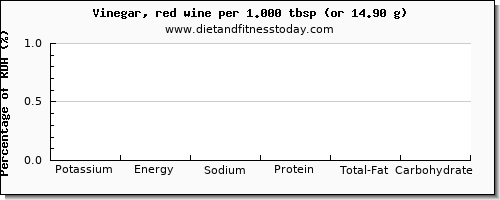
Macronutrients in Vinegar, red wine
The amount of protein, fat and carbs from this food described above is measured in grams per 100g and grams in a typical serving size (in this case 1.000 tbsp or 14.90 g), although it is also useful to give the number of calories from protein, fat and carbohydrate which are the most important macronutrients. For this serving in your diet here are the macronutrient calories. From protein the number of calories is 0.0 (kcal).The total calories from carbohydrate is 0.2 (kcal).
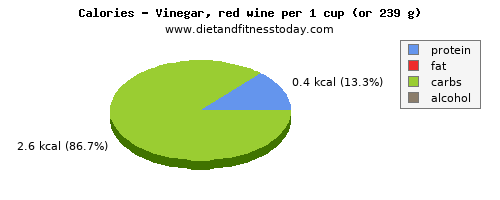
Milligrams of potassium in wine (per 100g)
This list of 12 types of wine, is brought to you by www.dietandfitnesstoday.com and ranges from Alcoholic beverage, wine, table, red through to Vinegar, red wine where all food items are ranked by the content or amount per 100g. The nutritional potassium content can be scaled by the amount in grams, oz or typical serving sizes. Simply click on a food item or beverage from the list at the bottom of the page to give a full dietary nutritional breakdown to answer the question how much potassium in wine.
The list below gives the total potassium content in the 12 items from the general description 'wine' each of which show the potassium amount as well as Energy, Sodium, Protein, Total Fat and Carbohydrate. Below, is the top 12 food items shown in the potassium chart. This gives a quick and easy dietary comparison for the different items, where each item is listed at the bottom of the page with a nutritional summary.
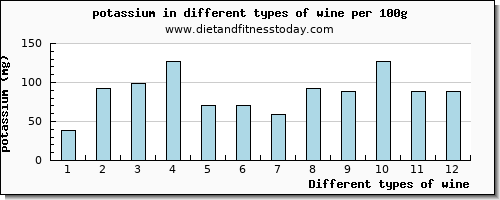
The corresponding nutritional value for wine based on our density score out of 100 (ranked by the amount of potassium per 100g) is shown in the below nutritional density chart. 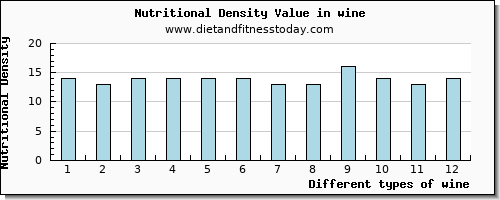
The corresponding Calories for wine ranked by the amount of potassium per 100g is shown below in the wine calories chart. 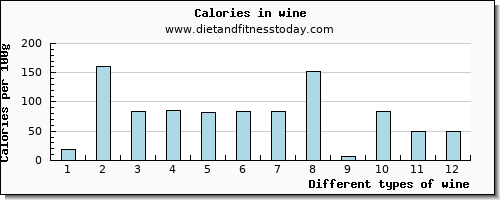
RDA for potassium
The recommended daily allowance for potassium is actually an adequate intake. The RDA for all of the nutrition data listed on this page is for 4.7g per day which is for males and females between the ages of 14 and 70+. For children between the ages of 1-3 years it is 3.0g, for children between the ages of 4-8 years it is 3.8g, and for children between the ages of 9-13 years it is 4.5g. For women during lactation between the ages of 19-50 years the level is slightly higher at 5.1g.
Average Content for wine
The average (or more correctly the arithmetic mean) amount of potassium contained in 100g of wine, based on the list below of 12 different items under the general description of wine, is 86.75 mg of potassium. This average value corresponds to 1.85 % of the recommended dietary allowance (or RDA) in your diet. The averages for the different nutrients are as follows; the average amount of Energy is 78.00 kcal, the average amount of Sodium is 57.83 mg, the average amount of Protein is 0.19 g, the average amount of Total Fat is 0.00 g and the average amount of Carbohydrate is g.
Median Amount
The median value of Potassium is found in Beverages, Wine, non-alcoholic which in 100g contains 88.00 mg of Potassium. This corresponds to 2 % of the recommended daily allowance. For this serving the amount of Energy is 6.00 kcal, the amount of Sodium is 7.00 mg, the amount of Protein is 0.50 g, the amount of Total Fat is 0.00 g and the amount of Carbohydrate is 1.10 g.
Highest potassium Content per 100g

Using the list below for the 12 different wine nutrition entries in our database, the highest amount of potassium is found in Alcoholic beverage, wine, table, red which contains 127.00 mg of potassium per 100g. The associated percentage of RDA is 3 %. For this 100g serving the Energy content is 85.00 kcal, the Sodium content is 4.00 mg, the Protein content is 0.07 g, the Total Fat content is 0.00 g, the Carbohydrate content is 2.61 g. 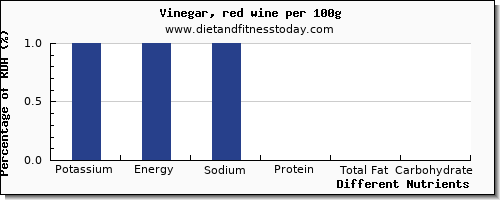
The lowest amount of potassium in 100g is in Vinegar, red wine which contains 39.00 mg. This gives as percentage of the recommended daily allowance 1 % of the RDA. For this 100g serving the amount of Energy is 19.00 kcal, the amount of Sodium is 8.00 mg, the amount of Protein is 0.04 g, the amount of Total Fat is 0.00 g, the amount of Carbohydrate is 0.27 g.
The difference between the highest and lowest values gives a potassium range of 88 mg per 100g. The range for the other nutrients are as follows; 66 kcal for Energy, 4 mg for Sodium, 0.03 g for Protein, 0 g for Total Fat, 0 g for Carbohydrate.
Highest Amount of potassium per Serving
Please remember that the above gives an accurate value in 100g for high potassium foods in your diet. For example 100g of Vinegar, red wine contains 39.00 mg of potassium. However, there are other factors to consider when you are assessing your nutritional requirements. You should also take into account portion sizes when you are considering the potassium nutritional content.
The food with the highest potassium content per typical serving is Alcoholic beverage, wine, table, all which contains 146.52 mg in 1.000 serving (5 fl oz) (or 148.00 g). The percentage of the recommended daily value for this serving is 3 %. For this serving the Energy content is 122.84 kcal, the Sodium content is 7.4 mg, the Protein content is 0.1 g, the Total Fat content is 0 g and the Carbohydrate content is 4.03 g.
Nutritional Information Summary
From the list below you can find a full nutrition facts breakdown for all foods containing potassium which can be scaled for different servings and quantities. We have also sorted our complete nutritional information and vitamin database of over 7000 foods, to give a list of
foods with a high amount of potassium.
Wine List, potassium Content per 100g
|
|
| | 1. Alcoholic beverage, wine, table, red - Potassium | | Nutritional Value : 14.00 / 100 food group - Beverages | Potassium
(%RDA) | Energy
(%RDA) | Sodium
(%RDA) | Carbohydrate
(%RDA) | Total Fat
(%RDA) | Protein
(%RDA) | | Profile for a 100g serving : | | 127.00 mg (3%) | 85.00 kcal (4%) | 4.00 mg (0%) | 2.61 g (2%) | 0.00 g (0%) | 0.07 g (0%) | | | Typical Serving size of 1.000 fl oz (or 29.40g): | | 37.34 mg (1%) | 24.99 kcal (1%) | 1.18 mg (0%) | 0.77 g (1%) | 0 g (0%) | 0.02 g (0%) | | | Other serving sizes 1.000 serving (5 fl oz) (or 147.00g): | | 186.69 mg (4%) | 124.95 kcal (6%) | 5.88 mg (0%) | 3.84 g (3%) | 0 g (0%) | 0.1 g (0%) | | | 2. Alcoholic Beverage, wine, table, red, Merlot - Potassium | | Nutritional Value : 14.00 / 100 food group - Beverages | | Potassium | Energy | Sodium | Carbohydrate | Total Fat | Protein | | Profile for a 100g serving : | | 127.00 mg (3%) | 83.00 kcal (4%) | 4.00 mg (0%) | 2.51 g (2%) | 0.00 g (0%) | 0.07 g (0%) | | | Typical Serving size of 1.000 fl oz (or 29.40g): | | 37.34 mg (1%) | 24.4 kcal (1%) | 1.18 mg (0%) | 0.74 g (1%) | 0 g (0%) | 0.02 g (0%) | | | Other serving sizes 1.000 serving 5 fl oz (or 147.00g): | | 186.69 mg (4%) | 122.01 kcal (6%) | 5.88 mg (0%) | 3.69 g (3%) | 0 g (0%) | 0.1 g (0%) | | | 3. Alcoholic beverage, wine, table, all - Potassium | | Nutritional Value : 14.00 / 100 food group - Beverages | | Potassium | Energy | Sodium | Carbohydrate | Total Fat | Protein | | Profile for a 100g serving : | | 99.00 mg (2%) | 83.00 kcal (4%) | 5.00 mg (0%) | 2.72 g (2%) | 0.00 g (0%) | 0.07 g (0%) | | | Typical Serving size of 1.000 serving (5 fl oz) (or 148.00g): | | 146.52 mg (3%) | 122.84 kcal (6%) | 7.4 mg (0%) | 4.03 g (3%) | 0 g (0%) | 0.1 g (0%) | | | Other serving sizes 1.000 fl oz (or 29.50g): | | 29.21 mg (1%) | 24.49 kcal (1%) | 1.48 mg (0%) | 0.8 g (1%) | 0 g (0%) | 0.02 g (0%) | | | 4. Alcoholic beverage, wine, dessert, sweet - Potassium | | Nutritional Value : 13.00 / 100 food group - Beverages | | Potassium | Energy | Sodium | Carbohydrate | Total Fat | Protein | | Profile for a 100g serving : | | 92.00 mg (2%) | 160.00 kcal (8%) | 9.00 mg (1%) | 13.69 g (11%) | 0.00 g (0%) | 0.20 g (0%) | | | Typical Serving size of 1.000 fl oz (or 29.50g): | | 27.14 mg (1%) | 47.2 kcal (2%) | 2.66 mg (0%) | 4.04 g (3%) | 0 g (0%) | 0.06 g (0%) | | | Other serving sizes 1.000 glass (3.5 fl oz) (or 103.00g): | | 94.76 mg (2%) | 164.8 kcal (8%) | 9.27 mg (1%) | 14.1 g (11%) | 0 g (0%) | 0.21 g (0%) | | | 5. Alcoholic beverage, wine, dessert, dry - Potassium | | Nutritional Value : 13.00 / 100 food group - Beverages | | Potassium | Energy | Sodium | Carbohydrate | Total Fat | Protein | | Profile for a 100g serving : | | 92.00 mg (2%) | 152.00 kcal (8%) | 9.00 mg (1%) | 11.67 g (9%) | 0.00 g (0%) | 0.20 g (0%) | | | Typical Serving size of 1.000 fl oz (or 29.50g): | | 27.14 mg (1%) | 44.84 kcal (2%) | 2.66 mg (0%) | 3.44 g (3%) | 0 g (0%) | 0.06 g (0%) | | | Other serving sizes 1.000 glass (3.5 fl oz) (or 103.00g): | | 94.76 mg (2%) | 156.56 kcal (8%) | 9.27 mg (1%) | 12.02 g (9%) | 0 g (0%) | 0.21 g (0%) | | | 6. Beverages, Wine, non-alcoholic - Potassium | | Nutritional Value : 16.00 / 100 food group - Beverages | | Potassium | Energy | Sodium | Carbohydrate | Total Fat | Protein | | Profile for a 100g serving : | | 88.00 mg (2%) | 6.00 kcal (0%) | 7.00 mg (0%) | 1.10 g (1%) | 0.00 g (0%) | 0.50 g (1%) | | | Typical Serving size of 1.000 fl oz (or 29.00g): | | 25.52 mg (1%) | 1.74 kcal (0%) | 2.03 mg (0%) | 0.32 g (0%) | 0 g (0%) | 0.15 g (0%) | | | 7. Alcoholic beverage, wine, cooking - Potassium | | Nutritional Value : 13.00 / 100 food group - Beverages | | Potassium | Energy | Sodium | Carbohydrate | Total Fat | Protein | | Profile for a 100g serving : | | 88.00 mg (2%) | 50.00 kcal (3%) | 626.00 mg (39%) | 6.30 g (5%) | 0.00 g (0%) | 0.50 g (1%) | | | Typical Serving size of 1.000 tsp (or 4.90g): | | 4.31 mg (0%) | 2.45 kcal (0%) | 30.67 mg (2%) | 0.31 g (0%) | 0 g (0%) | 0.02 g (0%) | | | Other serving sizes 1.000 fl oz (or 29.00g): | | 25.52 mg (1%) | 14.5 kcal (1%) | 181.54 mg (11%) | 1.83 g (1%) | 0 g (0%) | 0.15 g (0%) | | | 8. Alcoholic beverage, wine, light - Potassium | | Nutritional Value : 14.00 / 100 food group - Beverages | | Potassium | Energy | Sodium | Carbohydrate | Total Fat | Protein | | Profile for a 100g serving : | | 88.00 mg (2%) | 49.00 kcal (2%) | 7.00 mg (0%) | 1.17 g (1%) | 0.00 g (0%) | 0.07 g (0%) | | | Typical Serving size of 1.000 fl oz (or 29.50g): | | 25.96 mg (1%) | 14.46 kcal (1%) | 2.07 mg (0%) | 0.35 g (0%) | 0 g (0%) | 0.02 g (0%) | | | Other serving sizes 1.000 serving 5 fl oz (or 148.00g): | | 130.24 mg (3%) | 72.52 kcal (4%) | 10.36 mg (1%) | 1.73 g (1%) | 0 g (0%) | 0.1 g (0%) | | | 9. Alcoholic beverage, wine, table, white - Potassium | | Nutritional Value : 14.00 / 100 food group - Beverages | | Potassium | Energy | Sodium | Carbohydrate | Total Fat | Protein | | Profile for a 100g serving : | | 71.00 mg (2%) | 82.00 kcal (4%) | 5.00 mg (0%) | 2.60 g (2%) | 0.00 g (0%) | 0.07 g (0%) | | | Typical Serving size of 1.000 fl oz (or 29.40g): | | 20.87 mg (0%) | 24.11 kcal (1%) | 1.47 mg (0%) | 0.76 g (1%) | 0 g (0%) | 0.02 g (0%) | | | Other serving sizes 1.000 serving (5 fl oz) (or 147.00g): | | 104.37 mg (2%) | 120.54 kcal (6%) | 7.35 mg (0%) | 3.82 g (3%) | 0 g (0%) | 0.1 g (0%) | | | 10. Alcoholic beverage, wine, table, white, Chardonnay - Potassium | | Nutritional Value : 14.00 / 100 food group - Beverages | | Potassium | Energy | Sodium | Carbohydrate | Total Fat | Protein | | Profile for a 100g serving : | | 71.00 mg (2%) | 84.00 kcal (4%) | 5.00 mg (0%) | 2.16 g (2%) | 0.00 g (0%) | 0.07 g (0%) | | | Typical Serving size of 1.000 fl oz (or 29.30g): | | 20.8 mg (0%) | 24.61 kcal (1%) | 1.47 mg (0%) | 0.63 g (0%) | 0 g (0%) | 0.02 g (0%) | | | Other serving sizes 1.000 serving 5 fl oz (or 147.00g): | | 104.37 mg (2%) | 123.48 kcal (6%) | 7.35 mg (0%) | 3.18 g (2%) | 0 g (0%) | 0.1 g (0%) | | | 11. Alcoholic beverages, wine, rose - Potassium | | Nutritional Value : 13.00 / 100 food group - Beverages | | Potassium | Energy | Sodium | Carbohydrate | Total Fat | Protein | | Profile for a 100g serving : | | 59.00 mg (1%) | 83.00 kcal (4%) | 5.00 mg (0%) | 3.80 g (3%) | 0.00 g (0%) | 0.36 g (1%) | | | Typical Serving size of 1.000 fl oz (or 30.30g): | | 17.88 mg (0%) | 25.15 kcal (1%) | 1.52 mg (0%) | 1.15 g (1%) | 0 g (0%) | 0.11 g (0%) | | | 12. Vinegar, red wine - Potassium | | Nutritional Value : 14.00 / 100 food group - | | Potassium | Energy | Sodium | Carbohydrate | Total Fat | Protein | | Profile for a 100g serving : | | 39.00 mg (1%) | 19.00 kcal (1%) | 8.00 mg (1%) | 0.27 g (0%) | 0.00 g (0%) | 0.04 g (0%) | | | Typical Serving size of 1.000 tbsp (or 14.90g): | | 5.81 mg (0%) | 2.83 kcal (0%) | 1.19 mg (0%) | 0.04 g (0%) | 0 g (0%) | 0.01 g (0%) | | | Other serving sizes 1.000 cup (or 239.00g): | | 93.21 mg (2%) | 45.41 kcal (2%) | 19.12 mg (1%) | 0.65 g (1%) | 0 g (0%) | 0.1 g (0%) | | |
potassium and Nutritional Values - Top 221 Foods
Vegetablesleeks, turnip greens, swiss chard, mustard greens, yams, fennel, artichokes, broccoli, cauliflower, kale, green beans, brussel sprouts, cabbage, sweet potato, a potato, carrots, lettuce, iceberg lettuce, spinach, shiitake mushrooms, celery, salad, mushrooms, potatoes, baked potato, onions, asparagus, pumpkin, radishes, taro, turnips, okra, rhubarb, sweet corn, cowpeas, seaweed, broadbeansFruitsa banana, an apple, an orange, a peach, apricots, butternut squash, lemon, grapes, watermelon, strawberries, green grapes, kiwi, blueberries, zucchini, figs, honeydew, eggplant, dates, olives, a pear, coconut, cranberries, pomegranate, a mango, pineapple, cherries, cantaloupe, grapefruit, tangerine, nectarines, raisins, plums, tomatoes, chili peppers, chilis, peppers, avocado, cucumber, summer squash, winter squash, papaya, prunes, fruit salad, persimmonsSeafoodsalmon, cod, sardines, shrimp, tuna, fish, tuna salad, halibut, sea bass, scallops, crab, lobster, oysters, herring, haddock, halibut, mackerel, pike, pollock, troutDrinkscoffee, apple juice, cranberry juice, red wine, skim milk, white wine, wine, milk, beer, alcohol, coke, soy milk, whole milk, prune juice, tea, a shake, coconut milk, orange juice, energy drinks, soft drinks, grapefruit juice, lemon juice, lemonadeNuts and Seedschia seeds, sunflower seeds, pecans, pumpkin seeds, hazelnuts, nuts, almonds, sesame seeds, walnuts, cashews, peanuts, chestnuts, coconut meat, ginkgo nuts, mixed nuts, macadamia nutsBeans and Lentilssoybeans, pinto beans, kidney beans, lentils, black beans, lima beans, navy beans, beets, beans, garbanzo beans, baked beansMeatbeef, steak, deer, bacon, chicken, fried chicken, turkey, turkey breast, chicken breast, meatloaf, ham, lamb, sausages, chicken light meat, chicken dark meat, chicken leg, fried chicken, roasted chicken, chicken thigh, chicken wings, duck, goose, pheasant, quail, pigeon, turkey light meat, turkey dark meat, turkey breast, turkey leg, turkey wing, emu, ostrich, frankfurter, pate, pork sausage, salami, bratwurst, pork loin, ground pork, lamb shank, veal, bison, beef liver, beef ribsFast Foodsfrench fries, pizza, a slice of pizza, hot dog, hamburger, a cheeseburger, a big macDairy and Cheesericotta, yogurt, cottage cheese, an egg, egg whites, goats cheese, cheddar, cheddar cheese, cheese, hard boiled egg, feta cheese, mozzarella, low fat yogurtBread, Rice, Grains and Pastarye, millet, flaxseed, barley, buckwheat, whole wheat bread, a bagel, white bread, bread, quinoa, corn, spaghetti, rice, pasta, brown rice, white rice, cooked egg, mexican cheese, fruit yogurtSpreads, Sauces and Herbshummus, mayonnaise, butter, peanut butter, soy sauce, thyme, basil, rosemary, pepper, coriander, dill, parsley, spices, chili sauceSweets, Desserts and Snackspopcorn, chips, nachos, a granola bar, saltine crackers, cheesecake, jello, ice cream, doughnuts, chocolate, puddings, frozen yogurt, a snickers bar, croissants, danish pastry, english muffins, blueberry muffins, pie, pop tarts, coffeecake, crackers, potato chips, rice cakes, tortilla chips, fudge, puddings, syrups, dark chocolate, sundae, pretzels, pop tartsBreakfast Cerealgranola, cheerios, oatmeal, kelloggs cereals, general mills cerealsMiscellaneousspirulina, honey, sugar, brown sugar, tofu, olive oil, garlic, tempeh, oats, salad dressing, tomato soup, mushroom soup, chicken soup, vegetable soup, infant formula, cooking oil, shortening, fish oil, soybean oil, soy protein, gravy, raisins, currants, balsam pear, succotash, macaroni, egg noodles, japanese noodles, macaroni and cheese, burrito |









